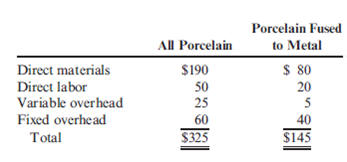
Cornerstones of Cost Management 2nd Edition by Don Hansen ,Maryanne Mowen
النسخة 2الرقم المعياري الدولي: 978-1111824402
Cornerstones of Cost Management 2nd Edition by Don Hansen ,Maryanne Mowen
النسخة 2الرقم المعياري الدولي: 978-1111824402 تمرين 30
Make-or-Buy, Traditional Analysis, Qualitative Considerations
Apollonia Dental Services is part of an HMO that operates in a large metropolitan area. Currently, Apollonia has its own dental laboratory to produce two varieties of porcelain crowns-all porcelain and porcelain fused to metal. The unit costs to produce the crowns are as follows:

Fixed overhead is detailed as follows:

Overhead is applied on the basis of direct labor hours. The rates above were computed using 8,000 direct labor hours. No significant non-unit-level overhead costs are incurred.
A local dental laboratory has offered to supply Apollonia all the crowns it needs. Its price is $265 for all-porcelain crowns and $145 for porcelain-fused-to-metal crowns; however, the offer is conditional on supplying both types of crowns-it will not supply just one type for the price indicated. If the offer is accepted, the equipment used by Apollonia's laboratory would be scrapped (it is old and has no market value), and the lab facility would be closed. Apollonia uses 2,500 all-porcelain crowns and 1,000 porcelain-fused-to-metal crowns per year.
Required:
1. Should Apollonia continue to make its own crowns, or should they be purchased from the external supplier? What is the dollar effect of purchasing?
2. What qualitative factors should Apollonia consider in making this decision?
3. Suppose that the lab facility is owned rather than rented and that the $22,000 is depreciation rather than rent. What effect does this have on the analysis in Requirement 1?
4. Refer to the original data. Assume that the volume of crowns is 5,000 all porcelain and 2,000 porcelain fused to metal. Should Apollonia make or buy the crowns? Explain the outcome.
Apollonia Dental Services is part of an HMO that operates in a large metropolitan area. Currently, Apollonia has its own dental laboratory to produce two varieties of porcelain crowns-all porcelain and porcelain fused to metal. The unit costs to produce the crowns are as follows:

Fixed overhead is detailed as follows:

Overhead is applied on the basis of direct labor hours. The rates above were computed using 8,000 direct labor hours. No significant non-unit-level overhead costs are incurred.
A local dental laboratory has offered to supply Apollonia all the crowns it needs. Its price is $265 for all-porcelain crowns and $145 for porcelain-fused-to-metal crowns; however, the offer is conditional on supplying both types of crowns-it will not supply just one type for the price indicated. If the offer is accepted, the equipment used by Apollonia's laboratory would be scrapped (it is old and has no market value), and the lab facility would be closed. Apollonia uses 2,500 all-porcelain crowns and 1,000 porcelain-fused-to-metal crowns per year.
Required:
1. Should Apollonia continue to make its own crowns, or should they be purchased from the external supplier? What is the dollar effect of purchasing?
2. What qualitative factors should Apollonia consider in making this decision?
3. Suppose that the lab facility is owned rather than rented and that the $22,000 is depreciation rather than rent. What effect does this have on the analysis in Requirement 1?
4. Refer to the original data. Assume that the volume of crowns is 5,000 all porcelain and 2,000 porcelain fused to metal. Should Apollonia make or buy the crowns? Explain the outcome.
التوضيح
1)Make or buy decision:
Make or Buy Dec...
Cornerstones of Cost Management 2nd Edition by Don Hansen ,Maryanne Mowen
لماذا لم يعجبك هذا التمرين؟
أخرى 8 أحرف كحد أدنى و 255 حرفاً كحد أقصى
حرف 255








